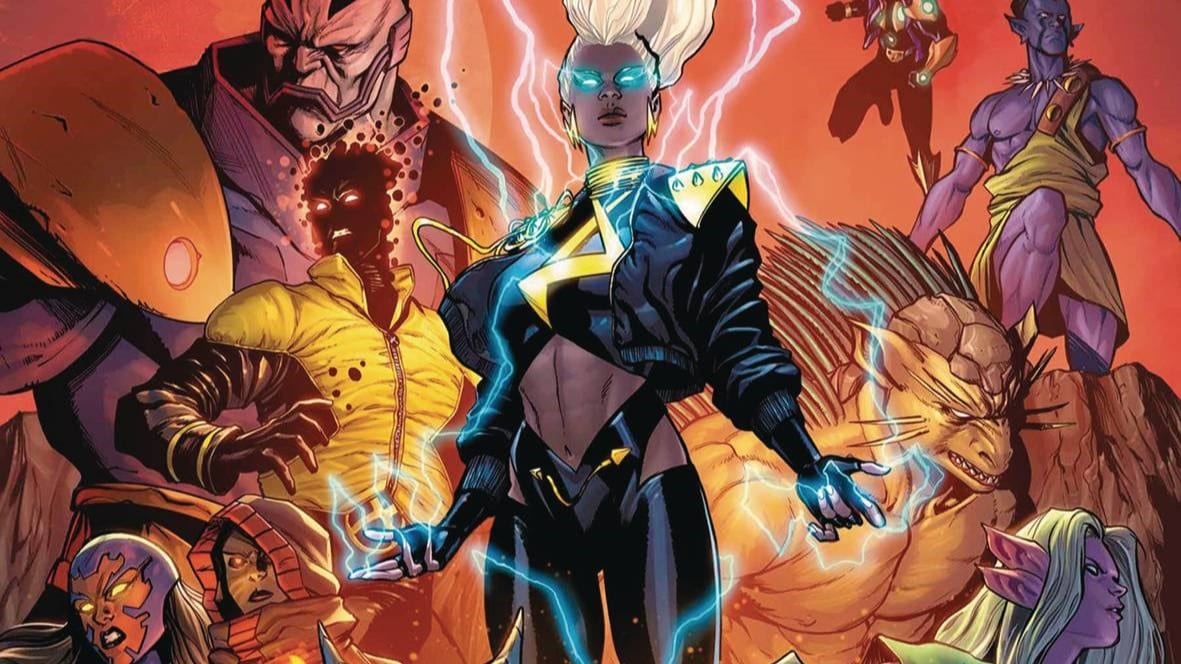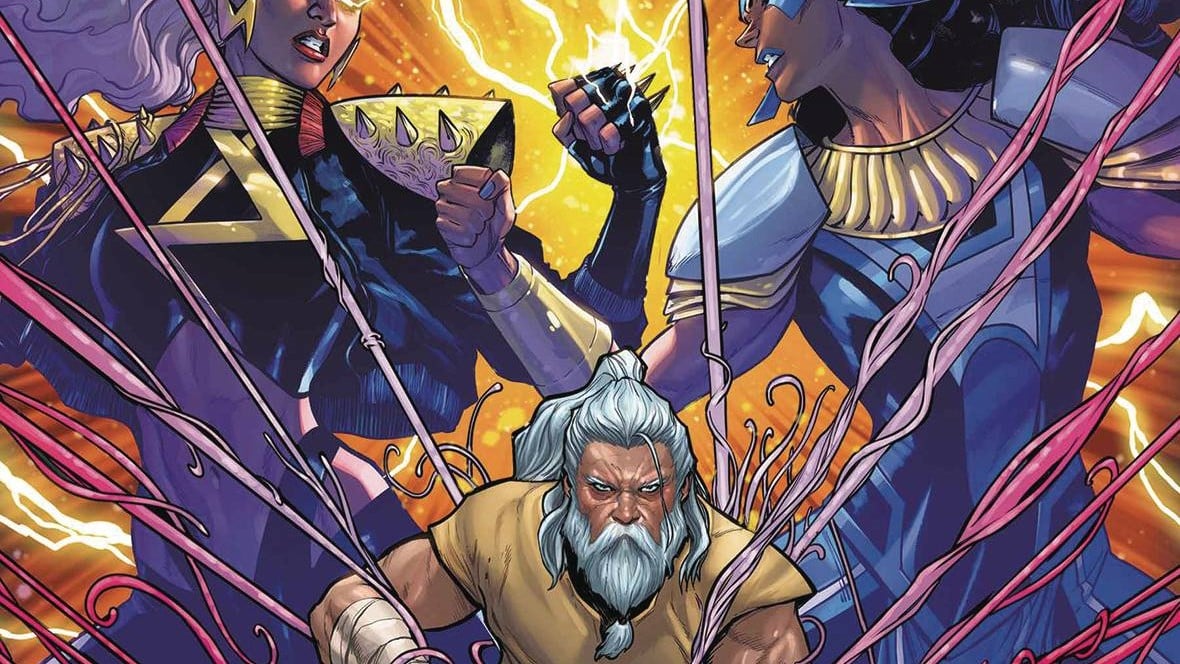An invocation, an invitation
“Our father; who art in heaven
Hollowed be thy name”
An appreciation, an ask of giving
“Thy kingdom come, Thy will be done
On earth as it is in heaven
Give us this day our daily bread
And forgive us our trespasses
As we forgive those who trespass against us”
The request; the reliqueshing of responsibility into eternal hands
“Lead us not into temptation
But deliver us from evil”
Amen.
For the past few months, as X-Men Red progressed (regressed?) into its alternate universe Sins of Sinister variant, Storm and the Brotherhood Of Mutants, I’ve lamented the lack of personhood in Storm. Yes, she’s present, yes she’s a leader and a giver, yea she does some truly amazing shit but…that’s kind of the problem. She does and does and does…
But what does she feel? What does she think? What motivates her actions beyond some banal, ill-defined idea of living?
My critique has been consistent: she’s the object of the drama, but not the subject. She doesn’t get the layers of love Sinister, or Destiny, or even her loyal acolyte Jon Ironfire get.
She just exists and, well, does.
My oft-repeated criticism of her usage as a magical negro, a hyper powered but emotionally bereft object, whose only purpose is to benefit those around her, again seems validated.
Except it’s not.
Here, in Brotherhood #3, my critique morphs into a strong compliment. For, in the context of this comic, I’m able to better contextualize her actions.
For there exists another entity that lacks agency, despite being all powerful; another entity whose entire purpose is to serve those who purport to serve it, to serve as an avatar and inspiration without truly being able to ask for – or receive – anything worth the entity’s sacrifice.
She’s a god. Our god.
A god venerated by those who knew her, whose memory serves as an inspiration for others, ultimately another version of herself – a God created by her worshipers to lead them away from the temptation of the devil and deliver them from evil.
And with this context, I can wholeheartedly embrace Sins of Sinister, not simply as a diversion and an underwhelming romp (which it is, along with a very mid Star Wars impression), but as a biting critique of religion, worship, and the role of God.
This is a brilliant, brilliant comic, both for how it’s designed and for what it ultimately means, not simply for the characters in the comic, but for us, the characters who read the comic.
Amen.
Invocation
The issue is narrated by those learned in the school of Lodus Logos, the poet whose words created metal. 1000 years into the future and, it seems, vita brevis, ars longa – life is short, but art is long – and his long art has outlived him be an eon.
Jon Ironfire, over 900 years old, appears to be one of the last survivors of Arakko, a name that means increasingly little to those (un)lucky enough to survive into the future. He, along with Khora (maybe, with her power boosting, the reason he’s still alive?) carry the literal torch-engulfed star-station forward, a burning castle as the last symbol of hope in the galaxy.
And yet, that symbol, that hope, runs the risk of being extinguished. A Sinister-infected Emma Frost, hot on the heels of our diamond headed original Sinister, is set to attack this outpost at the edge of the universe, seeking to take control of the remaining Moria clones who could reset the universe – and thus her power.
This is a lot to digest if you’ve not kept up with Sins of Sinister as a whole. This issue just does not make sense without context from the other books, requiring readers to read up on people and characters they may, intentionally want to avoid. This is not a great thing: past crossovers have been written in ways that allowed the reader to skip the other events if they so choose (think the King in Black tie-ins to S.W.O.R.D.).
Regardless, the diamond devil is in purgatory, asking the angels and saints to deliver him a god of their choosing to deliver him from an evil of his own making.
And they oblige. Of course they oblige. Who doesn’t want to make god in their own image?
Appreciations and Asks
An injection of DNA flows into an egg, made to be viable to hold life; A body molded from said DNA; a mind curried from the memories of one who worshiped her; powers amplified by a hopeful (Hopeless?) flame – Ororo rises again.
Do we not create our own gods, from our memories and interpretations of texts, to serve our whims? Do we not pray, ask, demand our God provide for us, protect us, act on our behalf, simply because we called for them?
Do we not ask our gods to look like us, talk like us, be who we want them to be?
Would we reject a god who dared look away, towards their own desires and away from ours?
Storm is a god, a yes, but a god in the way we want gods to be: powerful servants of our desires. Does Jon worship her and love her? Yes, totally. But is he worshiping a woman, or is he worshiping the idea of who he wants her to be?
Who do we worship? Who do I?
Lead Us Not Into Temptation
The Sons (and Daughters) of Sinister – those of the Krakoan circle, infected with the sinister strain, have a deftly different idea of godhood. Not beholden to others, they act to ensure others are beholden to them. Thus we see Emma, frustrated her assault is taking longer than she hoped, using clones as cannon fodder, asking those who gave to her to simply die for her.
The temptress who once turned into a diamond takes her place in the diamond-head of a gestalt: a space faring mecha with a whip, looking like a monochromatic, S&M version of Unicron.
It’s silly. It makes no sense.
It’s fucking awesome. I absolutely love it.
Emma is cold, robotic, augmented; A god of her own making and mechanisms. Compared to the resurrected storm: warm flesh, aware of her power but unaware of how to wield it, dependent on those who knew her to power her. A battle of faith, or, rather, a battle of faiths: self determination versus community, taking versus giving,
I versus we.
Her acolytes dying one by one, Storm may not remember how to win, but she also has one other advantage: She doesn’t remember how to lose, either.
She creates a nuclear blast, literally separating atoms from each other, destroying Emma, her robot, and those under her control in one blast.
I want to love this more than I do. I absolutely love the idea of it. But this is a place where the art has to take center stage, and while Vitti is great with details (see the age on Khora’a face, the insidious smiles of sinister, the rage and age of Ironfire), in this most pivotal of moments, I just kind of want more energy. More grandeur. Something more akin to his drawing of Storm as she rose from the egg, or the brilliant scene of Emma becoming a diamond voltron.
His work here is good, very good, but this scene deserved great.
Deliver Us From Evil
Storm’s blast kills all intended targets, and one unintended one – herself. Without the replacement five to heal her or ressurect her, she dies, again, an inevitable occurrence in such an unforgiving universe.
And of the inevitable: of course Sinister strikes again. He’s always been dangerous and conniving, but his puns and camp made him feel, well, less of a threat and more of a nuisance. Yet here, armed with a Doom gun and a smile, he finally feels evils, deprived – sinister. He (apparently) kills Ironfire. With Emma and her creations also killed, with the Storm system reduced to rubble, he has no one opposing him from taking the fate of the universe back into his hands.
This, of course, might be the most damning criticism of religion: no matter what you believe, it can all be undone by one cynical, conniving, caped man.
And if your religion can be undone so easily; if your faith yields no fruit, then what is the purpose of a god after all?
Sinister, in his desire to become that which he’s repeatedly defeated, should ask himself that question. For if nothing else is certain, nothing, not a diamond, not a remembered diety, not a dominion, can last forever.
Thoughts:
- What separates poetry from prayer? Intention, and the intention in the narration here is remembrance and veneration. It’s a prayer, to be sure.
- If Jon, like Rasputin, survives into the new timeline, I hope he brings his cyclops dog with him. Good boy. Goooood boy.
- I implore artists to learn how to draw a Black woman’s hair
- I wonder what the progenitors are doing?
A proud New Orleanian living in the District of Columbia, Jude Jones is a professional thinker, amateur photographer, burgeoning runner and lover of Black culture, love and life. Magneto and Cyclops (and Killmonger) were right.
Find more of Jude’s writing here.






